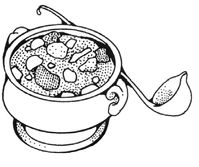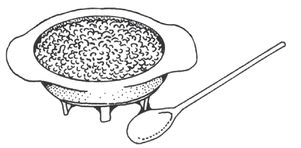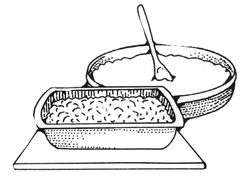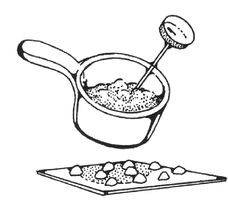Little Gale Gumbo (48 page)
Authors: Erika Marks

In so many ways, food ties us to our past and carries us into our futures. It is a means of preservation and celebration, and one we can all practice. I very much hope this novel inspires you to revisit the foods of
your
history and, better yet, share those treasured dishes with someone, a friend, or maybe a friend in the making. I'm always amazed at how much better something tastes when it's flavored with good company.
your
history and, better yet, share those treasured dishes with someone, a friend, or maybe a friend in the making. I'm always amazed at how much better something tastes when it's flavored with good company.
RECIPES
Being married to a native New Orleanian, I've been fortunate to learn firsthand many trademark dishes, and it's been quite an education. I can't tell you how many batches of pralines I ruined before achieving one of the buttery disks, or how many roux I burned before I finally conquered the recipes that my husband has been cooking for years. I hope you have as much fun making them yours.
Seafood GumboThere is no question that the trickiest part of making gumbo is the roux. As Camille says to Ben, roux “cook quickly and are easily ruined,” and it's true. Remember to serve your gumbo with some crusty bread, as you'll want to soak up every last drop.
Â
INGREDIENTS
1 cup oil
¾ cup flour
1 medium-size onion, chopped
1 bell pepper, chopped
3 stalks of celery, chopped
4 cups of seafood or chicken stock
1 28-oz. can of stewed tomatoes, undrained
1 tablespoon each of dried basil, oregano, thyme
¾ cup flour
1 medium-size onion, chopped
1 bell pepper, chopped
3 stalks of celery, chopped
4 cups of seafood or chicken stock
1 28-oz. can of stewed tomatoes, undrained
1 tablespoon each of dried basil, oregano, thyme

3 bay leaves
3 cloves of garlic, sliced
1 teaspoon Worcestershire sauce
1 lb. okra, chopped into coins
2 lbs. raw shrimp, peeled and deveined
(medium size)
1½ cups crabmeat, fresh or canned
2 tablespoons Creole seasoning
1 teaspoon of hot sauce
cooked rice
3 cloves of garlic, sliced
1 teaspoon Worcestershire sauce
1 lb. okra, chopped into coins
2 lbs. raw shrimp, peeled and deveined
(medium size)
1½ cups crabmeat, fresh or canned
2 tablespoons Creole seasoning
1 teaspoon of hot sauce
cooked rice
Â
DIRECTIONS
1. Heat oil in cast-iron pot on medium-high heat until it smokes. Slowly add flour, stirring as added. Continue stirring in constant motion very carefully, as splashed oil can burn, until mixture thickens and turns to a caramel color (10 to 15 minutes).
2. Add onion, pepper, and celery and continue to stir. Turn heat down to medium-low and keep stirring until onions are translucent (5 to 10 minutes).
3. Add stock to mixture and stir to incorporate.
4. Add stewed tomatoes, oregano, basil, thyme, bay leaves, garlic, and Worcestershire sauce and stir on medium heat, gently breaking up the tomatoes with the side of your spoon.
5. Add okra and stir. Turn heat down to low and let simmer for at least an hour, stirring occasionally. (Okra will break down and thicken the gumbo even further.)
6. Sprinkle peeled and deveined shrimp with Creole seasoning and toss gently.
7. Add shrimp and crabmeat to gumbo, turning heat up to medium and stirring continually until shrimp are cooked; then lower heat and cover.
8. Serve over rice.
Red Beans and RiceThere are few things more quintessentially New Orleans than red beans and rice. Traditionally they were made on Monday, otherwise known as wash day, because the dish could be left to cook on low heat for a long time. It is an easy and economical meal, and the perfect thing to make for your next big gathering. Be sure to use dried beans and not canned ones, because you'll want the starch to help with thickening. If andouille sausage isn't available, any smoked sausage will do; just make sure it's smoked, or else the coins will fall apart on you.
Â
INGREDIENTS
1 lb. dried kidney beans
1 onion, chopped
3 bay leaves
4 cloves garlic, crushed and peeled
2 tablespoons dried thyme
1 lb. andouille (or any available smoked sausage),
sliced into ¼-inch coins
salt and pepper to taste
cooked rice
hot sauce
1 onion, chopped
3 bay leaves
4 cloves garlic, crushed and peeled
2 tablespoons dried thyme
1 lb. andouille (or any available smoked sausage),
sliced into ¼-inch coins
salt and pepper to taste
cooked rice
hot sauce

DIRECTIONS
1. Rinse beans. Soak beans in glass bowl; fill with water an inch above beans and let soak covered overnight, adding water if necessary.
2. Pour beans and leftover soaking water into large, heavy stock pot over medium-high heat; add onions, garlic, and bay leaves. Add additional water, if needed, sufficient to cover beans. Bring to boil.
3. Reduce heat to simmer. Cover. Let simmer, stirring occasionally, until beans start to break down and soften (usually 2 hours, longer if necessary).
4. In final half hour, add sausage and thyme, and salt and pepper to taste.
5. Serve over rice with hot sauce.
(NOTE: Another great thing about the dish is that it can be made the day before and will taste even better the next day.)
Bread PuddingThere are many variations on bread pudding; this one is my contribution. I was on a mission to perfect my own recipe after tasting a sumptuous serving on my first trip to New Orleans in my twenties. I wasn't able to replicate a good whiskey sauce, but this one has enough brandy to make up for it.
INGREDIENTS
1 loaf of challah bread, cubed (approx. 4 cups)
1½ cups half-and-half
1 cup heavy cream
5 egg yolks
½ cup sugar
3 teaspoons vanilla
½ cup brandy
zest of 1 orange
¼ cup of orange juice
1 cup raisins
1 cup jarred butterscotch sauce
1½ cups half-and-half
1 cup heavy cream
5 egg yolks
½ cup sugar
3 teaspoons vanilla
½ cup brandy
zest of 1 orange
¼ cup of orange juice
1 cup raisins
1 cup jarred butterscotch sauce

Â
Â
DIRECTIONS
1. Cube challah; put in large bowl; set aside.
2. In separate bowl, mix raisins, orange zest, orange juice, and 1 tsp. of the vanilla. Cover and let sit for several hours (overnight, if possible).
3. Simmer creams in saucepan until warm.
4. In another small bowl, whisk together egg yolks, sugar, and remaining 2 tsp. of vanilla.
5. Add to cream mixture, making sure to temper first, and whisk gently until blended.
6. Whisk in brandy.
7. Pour mixture over cubed bread in bowl, stir gently to soak bread cubes, cover, and refrigerate for several hours (again, overnight is ideal).
8. Add raisins and remaining liquid to bread cubes and stir to combine.
9. Pour mixture into greased baking dish. Set baking dish in water bath and bake, uncovered, at 325°F.
10. After twenty-five minutes, drizzle butterscotch sauce over top of pudding and return to oven for another ten to fifteen minutes.
11. Serve warm with a few splashes of half-and-half.
PralinesPralines can be tricky to make but are well worth the effort. For those adept in candy making, the syrup may be deemed ready by dropping a bit into cold water and seeing a ball form. For myself, I still need a candy thermometer to guarantee success.
Â
INGREDIENTS
¾ cup each brown and white sugar
½ cup evaporated milk
pinch of salt
¼ teaspoon vanilla
1 tablespoon butter
1 cup pecans, slightly chopped
a cookie sheet lined with waxed paper
a candy thermometer
½ cup evaporated milk
pinch of salt
¼ teaspoon vanilla
1 tablespoon butter
1 cup pecans, slightly chopped
a cookie sheet lined with waxed paper
a candy thermometer
DIRECTIONS
1. In saucepan, heat sugars, milk, and salt. Heat on low, stirring continually and carefully, until the mixture turns the color of caramel.
2. Bring to a boil and insert candy thermometer; keep at a boil (still stirring) until temperature reaches 235°F. When it does, take off heat.
3. Add butter, vanilla, and pecans and stir gently to blend.
4. Drop onto waxed paper and let cool. The cooled disks will be slightly shiny.

QUESTIONS FOR DISCUSSION
1. From a young age, Dahlia and Josie see and react to their father, Charles, in very different ways, differences that bring conflict to the sisters' relationship as they mature. Discuss the opposing views the sisters have of their parents' marriage, and what impact those views have on how each sister securesâor rejectsâlove in her own life.
Â
2. The themes of loyalty and betrayal go hand in hand in this book. As devoted and loyal as they are to each other, Dahlia and Josie both bear the weight of some potentially devastating secrets. At the end of the book, some secrets have been revealed, but some remain. Do you think it's possible to live a life without secrets?
Â
3. Matthew feels a deep love for both sisters, but romantic love only for Dahlia, a feeling that has been allowed to grow due to his and Dahlia's off-and-on affairs over the years. By the end of the book, do you believe that Matthew has come to accept that Dahlia will never love him as deeply as he loves her? Do you believe he will finally move on from her? Conversely, do you believe by the novel's end that Josie has to come to accept that Matthew isn't in love with her, and that she and Wayne will be able to move forward to strengthen their marriage?
Â
4. The café is as much a character in the book as the men and women who cook and dine there, eventually becoming a fixture on the island. In your own life, have you ever known a place like the Little Gale Gumbo Café that became a staple in your community? What about it made it so appealing to its customers? Was it only the food or something more?
Â
5. Much like Ben and Camille, Dahlia and Jack's attraction is an unlikelyâbut undeniableâone. Even though Dahlia insists she doesn't want the complications and risks of love, she can't seem to get past her desire for Jack. What is it about Jack that makes him different in Dahlia's eyes from all the other men she's been with? What about him scares her so much that she works so hard to keep from letting him in?
Â
6. In obvious ways (climate, landscape), Maine and New Orleans couldn't be more differentâyet there are some similarities, such as a deep sense of history as well as a dependency on the fruits of their coastlines. At what point in the book do you think Camille and the sisters finally feel as if they are settled in their new home?
Â
Other books
Animosity by James Newman
The Road of Lost Innocence by Somaly Mam
Snow Storm by Robert Parker
The Rebel Spy by London, April
Blindfolded Innocence by Torre, Alessandra
Broken Together by K. S. Ruff
Tempting Dusty (Temptation Saga Book 1) by Helen Hardt
Lost! The Hundred-Mile-An-Hour Dog by Jeremy Strong
My Dog Doesn't Like Me by Elizabeth Fensham
A Prairie Dog's Love Song by Eli Easton
